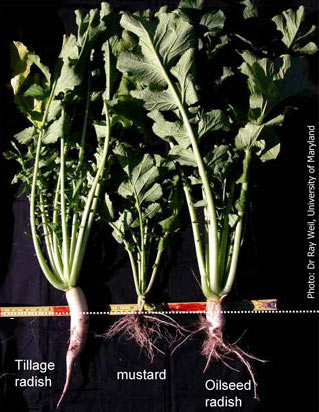
Radish cover crop
 While hanging
out with other farmer geeks last week, I discovered that
there is a cool new cover crop making the rounds --- radishes.
Everyone's glowing about the way tillage radishes, oilseed radishes,
groundhog radishes, fodder radishes, forage radishes, and daikon
radishes mellow clay soil, adding copious amounts of organic matter and
tilling through hardpan. If you play your cards right, you can
even graze your livestock on the radishes a time or two during the fall
since most of the cover crop biomass comes from the roots. What
really caught my interest, though, is news that these cover crop
radishes winter-kill
here in zone 6, meaning that they work perfectly with no-till systems.
While hanging
out with other farmer geeks last week, I discovered that
there is a cool new cover crop making the rounds --- radishes.
Everyone's glowing about the way tillage radishes, oilseed radishes,
groundhog radishes, fodder radishes, forage radishes, and daikon
radishes mellow clay soil, adding copious amounts of organic matter and
tilling through hardpan. If you play your cards right, you can
even graze your livestock on the radishes a time or two during the fall
since most of the cover crop biomass comes from the roots. What
really caught my interest, though, is news that these cover crop
radishes winter-kill
here in zone 6, meaning that they work perfectly with no-till systems.
I clearly had to give a
radish cover crop a try, but which one to choose? A little
research made the choice simpler since all of the names I listed in the
last paragraph refer to the same species (Raphanus
sativus.)
Now, to be fair, cabbage, broccoli, and collards are all members of Brassica
oleracea, so it's
clearly possible to come up with multiple subspecies that act quite
differently. But in the world of cover crop radishes, there is
really only one huge distinction --- the daikon radish has been bred to
be eaten while all of the others have been bred primarily for biomass
and are types of oilseed radishes. Groundhog radish and tillage
radish, specifically, are terms that plant breeders have trademarked
for their line of oilseed radishes.
 The
differences between the varieties seem to come down to the roots.
Many people want a long, thin taproot like that found in the tillage
radish, but we don't have hardpan, just heavy clay, so I chose to go
for a more branched root instead. That said, cover crop radishes
are so trendy that the ones I wanted the most were sold out and I had
to settle for a generic oilseed radish from Johnny's Select Seeds.
The
differences between the varieties seem to come down to the roots.
Many people want a long, thin taproot like that found in the tillage
radish, but we don't have hardpan, just heavy clay, so I chose to go
for a more branched root instead. That said, cover crop radishes
are so trendy that the ones I wanted the most were sold out and I had
to settle for a generic oilseed radish from Johnny's Select Seeds.
Before you go out and
seed your front lawn with radishes, though, I should warn you of one
factoid I noticed on every website. When oilseed radishes freeze
and rot over the winter, the resulting smell is quite foul. Maybe
it's best not to plant them beside your front door.
Want more in-depth information? Browse through our books.
Or explore more posts by date or by subject.
About us: Anna Hess and Mark Hamilton spent over a decade living self-sufficiently in the mountains of Virginia before moving north to start over from scratch in the foothills of Ohio. They've experimented with permaculture, no-till gardening, trailersteading, home-based microbusinesses and much more, writing about their adventures in both blogs and books.
Want to be notified when new comments are posted on this page? Click on the RSS button after you add a comment to subscribe to the comment feed, or simply check the box beside "email replies to me" while writing your comment.
- Remove comment
 Those radishes produce much less biomass --- they've been bred to be small and tender. But they are in the same species.
Those radishes produce much less biomass --- they've been bred to be small and tender. But they are in the same species.
- Remove comment
